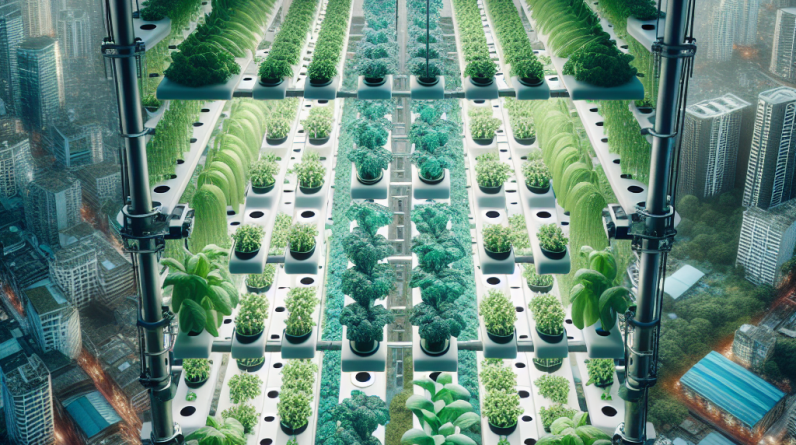
Understanding Hydroponics
What is Hydroponics?
Alright, let’s kick things off with the basics. Hydroponics is just a fancy term for growing plants without soil. Yup, you heard that right! Instead of dirt, we’re using nutrient-rich water to help our plants flourish. It’s like giving them a spa day every day! I first stumbled upon this concept when I was looking for ways to grow fresh herbs in my apartment and quickly fell down the rabbit hole of hydroponic gardening.
What’s super cool about hydroponics is that it allows you to control the environment your plants are in. No pesky weeds, no soil-borne diseases. Just clean, efficient growth. I’ve grown everything from basil to tomatoes, and I can assure you, they taste incredible! It’s a game-changer for anyone wanting fresh produce without the hassle of traditional gardening.
Plus, with the increasing urbanization, hydroponics stands out as a proactive solution to food scarcity, especially in densely populated areas. This method really brings the farm closer to the city, which is something I’m massively passionate about.
The Importance of Hydroponics in Urban Areas
Why Urban Farming Matters
Now, let’s chat about why hydroponics can be a beacon of hope for urban dwellers. With cities expanding and arable land disappearing, growing food within urban settings has become crucial. It’s not just about convenience; it’s about sustainability! Urban farming allows communities to tackle food deserts directly—areas where access to fresh produce is limited.
I’ve seen firsthand how community gardens and hydroponic setups can transform neglected spaces into vibrant food-producing hubs. When people are engaged in their food sources, it becomes more than just eating; it’s about taking back control over what we consume.
Additionally, urban hydroponic farms promote a sense of community and education. Many people start learning about agriculture, whether it’s aerobically growing lettuce on their balcony or participating in larger community initiatives, making everyone more aware of food issues.
Setting Up Your Hydroponic System
Choosing the Right System
When I first decided to set up my hydroponic system, I was like a kid in a candy store. There are so many options out there! From deep water culture to nutrient film technique, it can be a little overwhelming. But don’t sweat it! I recommend starting simple. A small, home-based system can be a great introduction.
I personally started with a basic Kratky method setup, which is incredibly beginner-friendly. It doesn’t require pumps or electricity! Just remember, the key is to pick a system that fits your space and energy availability. Don’t go overboard initially; enjoy the journey!
Also, remember to consider the types of crops you want to grow. Some plants thrive in hydroponics more than others. Leafy greens are usually the easiest and quickest to get started with, which is perfect for beginners like me.
Nutrients and Maintenance
Understanding Nutrient Solutions
Alright, so once you’ve got your system up and running, it’s time to talk about nutrients. This is crucial because plants need specific nutrients to thrive, and hydroponics requires a whole different ball game from traditional gardening.
When I first started, I made the mistake of underestimating the importance of a balanced nutrient solution. Hydroponic systems need a mix of macronutrients like nitrogen, phosphorus, and potassium, as well as several micronutrients. I recommend purchasing a pre-made nutrient solution that’s designed for hydroponics. It saves a lot of headaches!
As you get more comfortable, you’ll want to keep a close eye on the pH levels and nutrient concentration. Regular monitoring will go a long way in keeping your plants happy and healthy. Trust me, your plants will thank you with some lush, vibrant growth!
Community Impact and Future of Hydroponics
Hydroponics as a Social Movement
Okay, so let’s wrap things up by discussing the bigger picture. Hydroponics isn’t merely a trendy way to grow food; it often represents a shift in how communities interact with their food systems. Growing your own veggies can be liberating, and I’ve seen it create connections among neighbors as they share tips and even harvests!
There are so many exciting projects around the world incorporating hydroponics into communities—like schools teaching kids about sustainability or initiatives in food deserts. It makes me hopeful about the future of food. When people come together to grow, share, and learn, it creates a ripple effect that can drive change.
So, is hydroponics the answer to our food challenges? I believe it’s a valuable piece of the puzzle. As urban populations soar and climate change impacts agriculture, systems like hydroponics offer innovative solutions for the sustainable growth of food right where it’s needed.
FAQ
What is hydroponics?
Hydroponics is a method of growing plants without soil, using nutrient-rich water instead. This method helps optimize growth and reduces the risks associated with traditional soil farming.
Why is hydroponics important for urban areas?
Hydroponics is crucial for urban areas as it allows for local food production, helping to reduce food deserts and ensuring communities have access to fresh produce right where they live.
Which hydroponic system should a beginner use?
A beginner should consider starting with simpler systems, like the Kratky method, which doesn’t require electricity and is easy to manage.
How do I maintain the nutrients in a hydroponic system?
Maintaining nutrients involves regularly monitoring pH levels and the concentration of your nutrient solution. Buying pre-mixed nutrients can make this process easier, especially for beginners.
What impact can hydroponics have on communities?
Hydroponics can create community connections by encouraging neighbors to collaborate on gardening projects, educate about sustainability, and share access to fresh food. It’s all about building a sense of community while producing healthy food!







